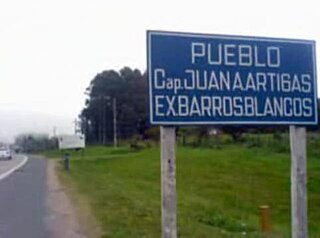Related Research Articles

The national flag of Uruguay is one of the three official flags of Uruguay along with the flag of Artigas and the flag of the Treinta y Tres. It has a field of nine equal horizontal stripes alternating white and blue. The canton is white, charged with the Sun of May, from which 16 rays extend, alternating between triangular and wavy. The flag was first adopted by law on 18 December 1828, and had 19 alternating stripes of white and blue until 11 July 1830, when a new law reduced the number of alternating stripes to nine. The flag was designed by Joaquín Suárez.
The Departamento de Canelones is one of the 19 Uruguayan departments. With an area of 4,536 km2 (1,751 sq mi) and 518,154 inhabitants, it is located in the south of Uruguay. Its capital is Canelones.

Las Piedras is a city in the Canelones Department of Uruguay. As of the census of 2011, it is the seventh most populated city of the country.

Tala is a town in the north of the Canelones Department of southern Uruguay.
Juanicó is a small industrial town located 35 km north of Montevideo, within the Canelones Department, Uruguay.
Progreso is a city in the Canelones Department of southern Uruguay.

San Ramón is a small city in the north of Canelones Department, in southern Uruguay.

Barros Blancos is a city in the Canelones Department of southern Uruguay. In 1976, it had been renamed to Juan Antonio Artigas, after commanding officer Juan Antonio Artigas, grandfather of the national hero José Gervasio Artigas, but the old name was reinstated in 2007.

Empalme Olmos is a village in the Canelones Department of southern Uruguay.

Montes is a village in the east of Canelones Department of southern Uruguay.

Cerrillos or Los Cerrillos is a very small city in the west part of the Canelones Department of southern Uruguay.

Salinas is a city and resort of the Costa de Oro in the Canelones Department of southern Uruguay.
San Bautista is a small city in the Canelones Department of southern Uruguay.

San Jacinto is a small city in the Canelones Department of southern Uruguay.
Santa Rosa is a small city in the Canelones Department of southern Uruguay.
Paso de Carrasco or Paso Carrasco is a city in the Canelones Department of Uruguay.

The Cathedral of Our Lady of Guadalupe is the main Roman Catholic church building of Canelones, Uruguay. It is the see of the Roman Catholic Diocese of Canelones since 1961.
Battle of Sauce was a Uruguayan battle between the Blancos army under the command of Timoteo Aparicio, and the Colorado government troops, under Colonel José Gregorio Suárez. It occurred on the banks of the Arroyo del Sauce, Canelones Department, during the Revolution of the Lances.

Nelson Adrián Peña Robaina is a Uruguayan businessman and politician of the Colorado Party. He served as the first Minister of the Environment from August 27, 2020 to January 30, 2023.
THe interim governorship of Joaquín Suárez was the pre-Constitution government period of Uruguay which began after his appointment by the Constitutional Assembly as the interim substitute Governor and Captain General from 2nd December until 22nd December 1828 when the elected Governor and Captain General José Rondeau assumed his charge. During the twenty days of this brief period the cessation of all foreign authorities on the territory was ordered and several national symbols were established.
References
- ↑ 25 August 1825
- ↑ History of the Cathedral of Canelones Archived 2016-08-09 at the Wayback Machine (in Spanish)